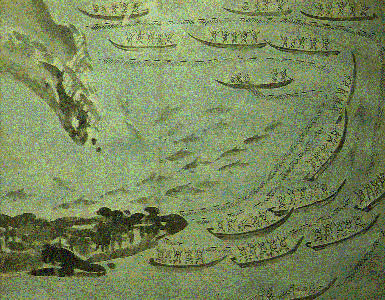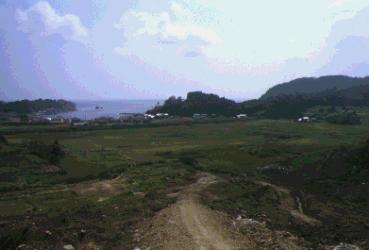Dolphinü@Hunting/Fishingü@of
the Jomon Period
An illustration of Pre-modern fishing
at Noto drawn in 1838 comments that it took two days to catch all of a
thousand dolphins driven into an encircling net.
 |
During the last thirty years, there have been important
findings in the whaling history of Japan or East Asia. First, in January
1972, a prehistoric engraving was found on a rock wall facing a dam near
Ban-gu Dae in Kyongsan Namdo in southeast
Korea, which shows various whales or whaling scenes. Second, in 1982 and
1983, numerous dolphin-bones of the Jomon-period were excavated from the
Mawaki site in Ishikawa Prefecture. The Mawaki site excavation led me to
a study of prehistoric whaling and to identify species of whale pictures
on the rock engraving at Ban-gu dae. Therefore, I'd like to talk about
Mawaki and then about the development from the dolphin hunting to the larger
whale hunting through the find of Ban-gu Dae.
The Mawaki site is a wet site at the entrance of Toyama
bay. A shell midden has not been found there despite shells in the boring
cores of a 1998 survey. The shells were almost natural deposits from sea
drifts. Numerous dolphin-bones also remained thanks to the wet-soil environment.
Before the excavation of the Mawaki site, good sites for dolphin bones
were known, for example, the Asahi shell midden in Toyama Prefecture, the
Natagiri cave in Chiba Prefecture and the Irie shell midden in Hokkaido.
There is not however conclusive evidence for dolphin/porpoise hunting in
the Jomon-period. The mere existence of many cetacean remains is generally
not sufficient evidence for whaling, because whales sometimes get stranded
on shore. However, dolphin hunting is quite possible by taking skillful
advantage of animal behavior and geographical features. Special tools are
not required since the driving method using boats, oars and, stones or
poles to make sounds, can be effective if there are enough crew-members.
On the other hand, for several reasons the Mawaki is an ethno-archeological
field very suited to studying dolphin hunting/fishing. 1) The dolphins
amount to 90% of the minimum number of the animals here. 2) It is an exceptional
feature of the Jomon assemblage in the Hokuriku Districts that stone spear
points are one of the elements that compose the main stone tools from the
Mawaki site. 3) Of the dolphin atlases from Stratum ç]çT, 60% from Pacific
White-sided Dolphins and 34 % from Common Dolphin . 4) A book on the natural
history of Toyama, written in the early 18th century, describes a thrusting
method with harpoons used for Pacific White-sided Dolphins because a netting
method was unsuitable. 5) According to the compilation by the Japanese
Fisheries Agency from 1886 to 1895, the structure of netting for Pacific
White-sided Dolphin hunting is different from the Common Dolphin hunting
at Tako in Izu Peninsula, because the former is agile and skillful in groups,
making it difficult to hunt. 6) An illustration of Pre-modern fishing at
Noto drawn in 1838 comments that it took two days to catch all of a thousand
dolphins driven into an encircling net. 7) A picture postcard in the 1910s
shows Common Dolphin hunting by the net-driving method at Ogi near Mawaki.
8) The open sea side of the Noto Peninsula is subject to frequent stranded
whales, and the other side facing Toyama Bay, where the Mawaki site lies,
is subject to the incidentally taken whales by stationary net fishery today.
In the Pre-modern period, the supply of whales on the open seaside mainly
depended on stranded or strayed whales, and whaling by stationary nets
was flourishing on the bay side, too. We have no document and folklore
of mass stranded dolphins on the Noto Peninsula.
This site yielded more than 286 dolphins from the layers of the later Early
to Final Jomon-period. It is characteristic of dumps nearby a fishing ground
and butchery in that the proportions of the main parts of skeletons are
similar to the site as a whole. However, one area of concentrated bones
lacks the main parts of one dolphin, from the cranium to the coccyx. Individual
identification of many bones is necessary to reveal how each part of a
dolphin skeleton is distributed in an excavated area. We investigated in
detail the dolphin remains from Stratum ç]çT, the later Early or early
Middle Jomon-period, in an excavation grid of 6m by 15m with half-meter
squares, with most dolphin remains at the site.
My first individual identification analysis was a pair matching of the
humeri, which were excellently preserved parts of the pectoral-fin bones
(humeri, radiuses and ulnas). These bones have very few cut marks ü\ only
one (8%) in 132 humeri and none in the radiuses or ulnas. On the other
hand, there were six (3.2%) cut marks in 190 scapulas. Moreover, there
are many humeri articulated with radiuses or ulnas in the remains. It shows
that the pectoral fins were cut off between the proximal ends of humeri
and the distal ends of scapulas. Many humeri pairs should have bee found
if the pectoral fins had not been taken and used, however, out of 56 left
humeri and 60 right humeri, there was only one pair matching. Both the
left and right humeri of the pair were found within a half meter square.
Therefore, pectoral fins may have been useful and shared for some reason.
Many units of vertebrae of size easy to carry are found in an articulated
state, about 50 to 70 cm in length. Three sets (9.4%) in 64 vertebral units
were determined with high probability belong to those of the same individual.
They were also found within a half or one meter square, too. It is remarkable
that another example is of Bottlenose Dolphin size and consists of 15 vertebrae
from the lumbar to the caudal, and is 71cm in length. An end of the unit,
there are cut marks in the direction of the cranial-caudal line on the
caudal base of left and right processus transversi. I regard the cut marks
as incisions caused by dividing articulated vertebrae covered with strong
ligaments into sections, though it is a hard task, for fishermen sharing
a dolphin.
According to 13C and 15N analysis of human bone collagen,
the â┬13C and â┬15N values increase in proportion
with their dependence on ocean animals, especially marine mammals. The
â┬13C for three samples from the Jomon-period sites in the Hokuriku
district are as follows: -17.0 per mill for the Mawaki Site, -17.3 per
mill for the Akaura shell midden, and -18.5 per mill for the Kamiyamada
shell midden. The most oceanic site of the three is the Mawaki site, producing
numerous bones of dolphins at the entrance of Toyama bay. The second is
the Akaura shell midden mainly with salt-water fish bones and shells on
the inside of Nanao Bay. The Kamiyamada site is most influenced by land
water. It is, therefore, a natural result that the values are arranged
in the order of Mawaki, Akaura, and Kamiyamada. However, there is little
difference between these values. The â┬15N values for Mawaki
and Kamiyamada are respectively +12.0 per mill and +8.2 per mill; the graph
of the â┬13C and â┬15N composition shows that Mawaki
belongs to the oceanic group of the North-east to Central Honshu.
Nuts such as conker, walnut and chestnut, a causal factor in the lower
value of â┬13C and â┬15N, were hardely excavated
from the Mawaki site, though there were a number of chestnut tree remains
and pollen fossils. Nut remains are probably also buried in the unexcavated
earth at the site. Numerous fish bones, mainly mackerel, skipjack and sardine,
were also excavated from the site. At the Mawaki site, artifacts from the
Jomon-period to the Pre-modern period have been found. Many advantages
of the food resources including a dolphin are important factors in the
formation of a multistratified site.
An individual identification analysis of Pacific White-sided Dolphin atlases,
crania and periotic bones shows that the most closely concentrated unit
were 21 dolphins. These dolphins were mainly, however, associated with
two types of pottery: the later Early and the latest Early Jomon. One unit
of the concentration generally consisted of 7 dolphins or less. Although
from the findings it is difficult to give an absolute figure, I estimate
that there were between several to several tens of dolphins in a catch.
It is conceivable that sometimes dolphins were cut up when the catch was
shared amongst the participants or neighboring settlements. Reciprically
sharing the dolphins would be advantages to nearby settlements. The dried
or smoked meat is traded over a wide area. A custom of sharing makes a
network for mutual aid, so to speak, social insurance between settlements
or regions.
(Hiraguchi, 1999)

- Miyazaki, N., and Hiraguchi, T., 1986, Animal Remains.
The Mawaki Site, edited by T Takahori and Y. Yamada, 346-400 The
Noto-machi Board of Education. (In Japanese)
- Hiraguchi, 1986, The Mawaki site: a site in the Snowy
Area along the Sea of Japan. Archaeological Quarterly, 15:71-72.
Yuzankaku Press, Tokyo. (In Japanese)
- HIraguchi, T., 1986b, Catching Dolphins at the Coast
of Toyama Bay in the Jomon Period. Ozakai, 10:51-68. The
Archaeological Society of Toyama. (In Japanese)
- Hiraguchi, T., 1987, Fossil atlases of dolphins from
the Mawaki site, Noto Peninsula. Bulletin of the Japan Sea Research
Institute Kanazawa University. 19üF181-206. (With a summary in English)
- Hiraguchi, T., 1989, Catching dolphins of the Jomon
period: Concerning a regional characteristic of the Hokuriku. Jounal
of the Archaeological Siciety of Ishikawa, 32:19-38. Kanazawa. (In
Japanese)
- Hiraguchi, T.,1991, An individual
identification analysis of animal remains: Pairing the dolphin humeri from
the Mawaki site. Bulletin of the National Museum of Japanese History.
29üF61-84. (With a summary in English)
- Hiraguchi, T., 1992, Catching dolphins at the Mawaki
Site, Central Japan, and its contribution to Jomon society. Pacific
Northeast Asia in Prehistory: Hunter-Fisher-Gatherers, Farmers and Socio-political
Elites. Pullman: WSU Press. 35-45. (In English)
- Hiraguchi, T., 1993,
A Study of Jomon-period Dolphin Fishing by an Individual Identification
Analysis of Animal Remains: Grant-in Aid for Scientific Research (C),
1992. (With a summary in English)
- Hiraguchi, T., 1994, Individual identification analysis
of dolphin remains on the zoo-archaeology, Nihonkai Cetology, 4:43-52.
- Hiraguchi, T., 1996, An Individual identification analysis
on metrical and non-metrical characters of dolphin bones from archaeological
sites: its theoritical and methodological study. (In Japanese)
- Hiraguchi, T., 1996b, Butchery
marks in the case of an articulated vertebrae of dolphin, excavated from
the Mawaki site in the Noto district, Central Japan. Nihonkai Cetology,
éUüF15-20. (With a summary in English)
- Hiraguchi, T., 1997, Anü@Individualü@Identification
Analysis on Metrical and Non-metrical Characters of Dolphin Bones from
Archaeological Sites: Grant-in-Aid for Scientific Research (C), 1995.
(With a summary in English)
- Hiraguchi, T., 1999, Prehistoric Whaling on the Coast
of Japan, Abstracts of COE (Center of Excellence) Project International
Symposium: Bones and Woods as Human Resource, Revealed by Archaeological
Scientific Analysis. Nara National Cultural Properties Research Institute,
February 9, 1999. 51-52.

Distant view of a small bay from a hill behind the Mawaki
site 1982.



